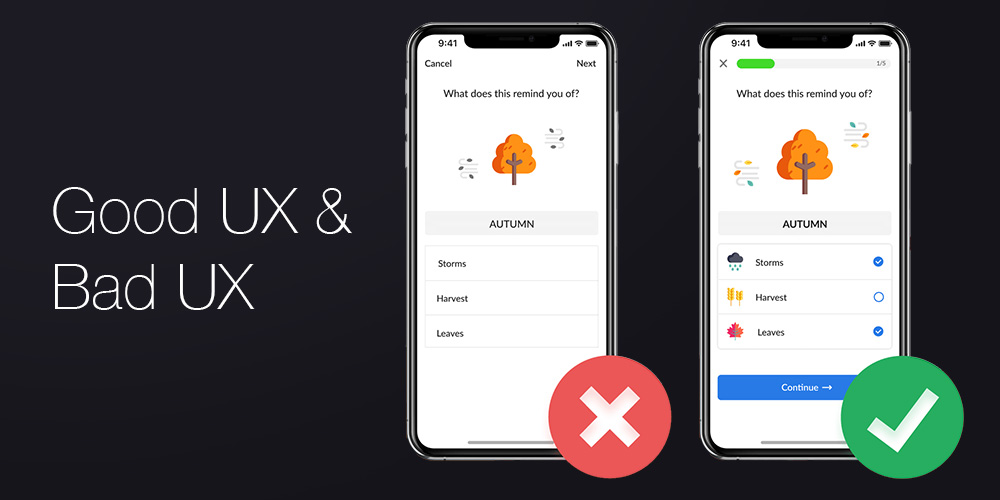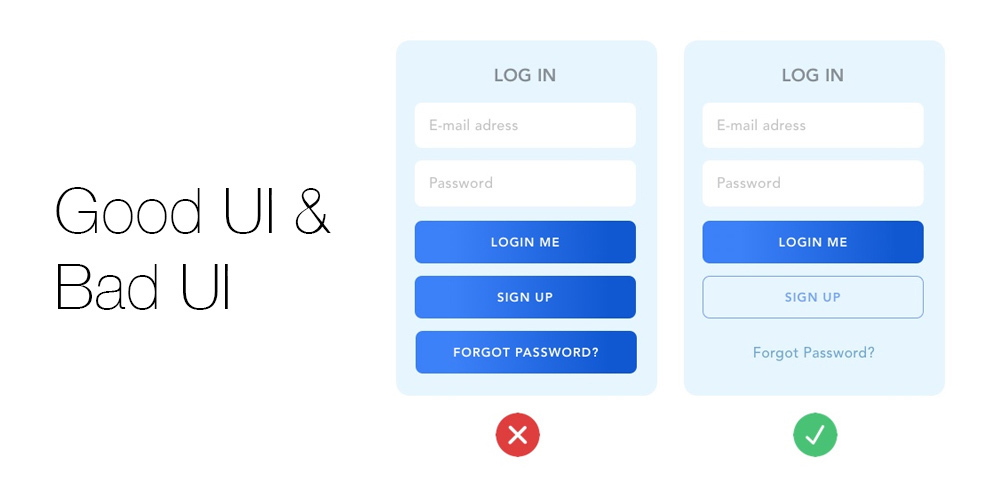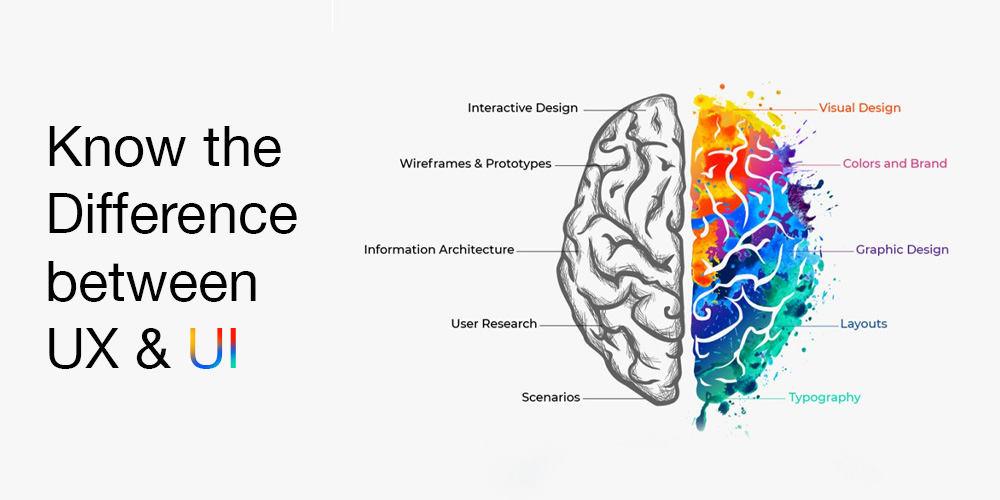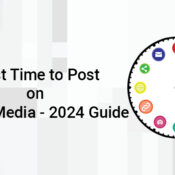08/11/2021
/
UX vs UI: How Are They Different in Their Roles?
Breaking down UX vs UI for a clear understanding, take a look.
Often used interchangeably and incorrectly, the terms UX vs UI follow countless analogies to explain the concept. However, the perpetuated confusion stands in between to make it impossible to pin down an ultimate viewpoint. With this comes a bulging sack of questions related to UI/UX. Below, we have a breakdown of what the article is going to cover about UX and UI. Take your coffee because you’ve stumbled upon the most comprehensive UX vs UI blog post.
The terms ain't new in the world of design.
Primarily, UI and UX are user-oriented elements and are meant to enhance user interaction and user experience. Wondering how end-user reaction changes with something so minute as UI and UX?
 You may find a range of key differences between UX and UI, but the relationship between UI and UX is directly proportional as any improvement in UI will eventually improve UX. In an era where competitors are fighting tooth and nail to grab the attention of their online audience, focusing on UX vs UI can be a chartbuster for performance. Let’s go through it in detail.
You may find a range of key differences between UX and UI, but the relationship between UI and UX is directly proportional as any improvement in UI will eventually improve UX. In an era where competitors are fighting tooth and nail to grab the attention of their online audience, focusing on UX vs UI can be a chartbuster for performance. Let’s go through it in detail.
 Approaching a human-first way of designing products would let you interact with the end-user and shape their experience easily.
Approaching a human-first way of designing products would let you interact with the end-user and shape their experience easily.

 The primary difference between User Interface (UI) and User Experience (UX) is UX talks about the user’s experience with a particular product or service, while UI is all about the aesthetic appeal that products make to the end-user. Typography, colors, menu bars, etc. comes under UI, while UX appeals to improve the end-user journey through the product. The integral vistas of UI and UX go hand in hand, even with these persisting differences. Consider these elements carefully to strengthen your brand identity.
I hope after going through all this, the confusion between UX vs UI is now crystal clear.
The primary difference between User Interface (UI) and User Experience (UX) is UX talks about the user’s experience with a particular product or service, while UI is all about the aesthetic appeal that products make to the end-user. Typography, colors, menu bars, etc. comes under UI, while UX appeals to improve the end-user journey through the product. The integral vistas of UI and UX go hand in hand, even with these persisting differences. Consider these elements carefully to strengthen your brand identity.
I hope after going through all this, the confusion between UX vs UI is now crystal clear.
UI and UX in 100 Words
The UI design sums up the visual design elements - typography, color, images - to add a pinch of the inclusive and digestible interface. UI elements enhance the product’s life by creating an emotional connection between the product and the end-user. It defines UI as a process of transforming wireframes into a professional and approachable graphical user interface. UX design constitutes multiple user interfaces that collaborate to form a product. UX is an individual’s interaction with a company’s products and services. UX can be positive, negative or neutral and will affect the experience of the user accordingly. You may find a range of key differences between UX and UI, but the relationship between UI and UX is directly proportional as any improvement in UI will eventually improve UX. In an era where competitors are fighting tooth and nail to grab the attention of their online audience, focusing on UX vs UI can be a chartbuster for performance. Let’s go through it in detail.
You may find a range of key differences between UX and UI, but the relationship between UI and UX is directly proportional as any improvement in UI will eventually improve UX. In an era where competitors are fighting tooth and nail to grab the attention of their online audience, focusing on UX vs UI can be a chartbuster for performance. Let’s go through it in detail.
What makes UX Design so Important?
First thing first, the entire design industry pivots around the user and user experience. With user experience, we mean how people interact with your product, the company, and its services. For instance, when we open a door, we interact with the doorknob, lock and material quality- which eventually perpetuates our experience with it. A poor-quality knob may thwart our ability to use it again. The UX is applicable to everything tangible that users use, be it a website, a chair, a coffee machine, or any gadget. Clear? Likewise, the conformation of the final product cues the usability, usefulness, and desirability of the product. In the digital world, user experience design supports user behavior through interaction with a digital product and leaves its impact on them. People, after using a product, perform a thorough evaluation of their experience based on multiple factors. Some of them are listed below: Basic Impressions - Pleasant, Average or Bad? Usability - Easy, Average or Tough? Functionality - As per expectations or failed expectations? Value - Delivers Value or Not? Desirability - Will They Use It Again Or Not? The emotional instinct of humans overpowers every other aspect. UX is simply how users feel and think about your brand. Rendering both emotional and rational touch to your product, UX helps the user connect with it, thus playing a significant role. The context of the product also affects user experience and is essential to understand the use of the final product in a real-life scenario. When people are new to a product, they get a mixed feeling about it, and this feeling changes over time once they get familiar with it. So, rather than considering UX vs UI, work on both as they are different entities that go together. See how? Bad UX vs Good UX Approaching a human-first way of designing products would let you interact with the end-user and shape their experience easily.
Approaching a human-first way of designing products would let you interact with the end-user and shape their experience easily.
UX Designer Creates Opportunities
Picture this- You are about to check out an online shopping process. How does the cart affect your purchase? Is it easier to navigate back and forth to add to the cart? Does it allow you to enter your online banking app details to simplify the purchase flow? UX designer is supposed to consider all the facets of a product to create simple, pleasant, accessible, resourceful, and relevant for subtle user experience. It focuses on the overall feel and not only visuals.What makes UI Design so Important?
The first point of interaction between humans and machines is UI, the interactive visual element of a product interface. User interface design is designed for machines and software to maximize usability and user experience. Simply put, everything that a user comes in contact with to use a digital service or product is UI, be it a keyboard, light, sound, touch screen, screen, etc. The moment you strike your figure on your mobile to scroll up or down...Yes… the touch screen is given with an interactive UI or the buttons you press on the touchpad of the coffee machine to select your coffee. This is when you use UI. UI has undergone groundbreaking evolution ever since it came. Wreathed to multiple misinterpretations, the term UI is still struggling to establish its worth. In clear words, Try to remember a brand- say, MacDonald, do you remember any color or something associated with it? Remember that mannequin in red and yellow sitting outside every McDonald's outlet? Such things differentiate a brand UI from others. You might have seen websites that follow a particular color theme, typography or image pattern that converge the identity of the brand. Adding interactive elements - including color schemes, icons, buttons, typography, spacing, and responsive design to your website - will keep users hooked and navigating all through. When we talk about UX vs UI, UI has two important elements- virtual design to convey the look and feel of the product and interaction design to ensure the functional and logical classification of elements. UI complements UX by enhancing the overall presentation, including the look, feel and interactivity of a product.Bad UI vs Good UI

Difference between UI and UX
A quick overview - Think of designing a house - two things are of prime concern. Foundation, i.e., UX Paint, furniture and outer appearance, i.e., UI The primary difference between User Interface (UI) and User Experience (UX) is UX talks about the user’s experience with a particular product or service, while UI is all about the aesthetic appeal that products make to the end-user. Typography, colors, menu bars, etc. comes under UI, while UX appeals to improve the end-user journey through the product. The integral vistas of UI and UX go hand in hand, even with these persisting differences. Consider these elements carefully to strengthen your brand identity.
I hope after going through all this, the confusion between UX vs UI is now crystal clear.
The primary difference between User Interface (UI) and User Experience (UX) is UX talks about the user’s experience with a particular product or service, while UI is all about the aesthetic appeal that products make to the end-user. Typography, colors, menu bars, etc. comes under UI, while UX appeals to improve the end-user journey through the product. The integral vistas of UI and UX go hand in hand, even with these persisting differences. Consider these elements carefully to strengthen your brand identity.
I hope after going through all this, the confusion between UX vs UI is now crystal clear.
Role of UI and UX in Web Designs
User satisfaction with the product is the final goal. Combining different elements and using them on a website to make it efficient and highly functional. While creating a website, the design holds central attention. For this, UI focuses on visual elements to decide on how to convey the important information in a simple and achievable way. UX enhances the user journey through the website making it easy for them to traverse through it. These two elements improve the overall user interaction with the brand. As an established Web Designing Company, we pay attention to every aspect of website design and development to amalgamate and converge it on a whole.How Important UX and UI Designs Are?
Guiding users with an intuitive experience is what makes a website user-friendly. And we all know that user-friendly websites are loved by both users and search engines. It enhances credibility, consistency, coherence and contributes to overall site performance. These elements enhance the brand's strength and retain more users to visit time and again as valuable customers. On the other hand, if they encounter issues with any of these, the chance of their return diminishes. It validates the importance of UI and the Importance of UX altogether. Have any queries? Contact us.Recent Posts
Monika Narriya/0 Comments
Which is the best ERP solution provider company?
Monika Narriya/0 Comments
How do we select the right ERP solution for our businesses?
Sumit Kumar/0 Comments
9 Most In-Demand Programming Languages for 2024
Sumit Kumar/0 Comments
Best Time to Post on Social Media – 2024 Guide
Sumit Kumar/0 Comments
Why You Should Consider Semantic HTML for SEO
Sumit Kumar/0 Comments
How ERP Software can Streamline the Manufacturing Process in the Electrical Panel Industry
All Categories
- Bing
- Blockchain
- Blog
- Branding
- Case Study
- Content Marketing
- Conversion Rate Optimization
- Cryptocurrency
- Digital Currency
- Digital Marketing
- Email Marketing
- ERP Solutions
- Facebook Marketing
- Google Ads
- Google Updates
- Graphic Designing
- Hire Developers
- Image SEO
- Influencer Marketing
- IT
- Local SEO
- Machine Learning
- Mobile Application Development
- Pay Per Click
- Pinterest SEO
- Podcast Hosting
- React JS
- Reddit & Quora
- Search Engine Optimization
- SEO Copywriting
- Social Media Marketing
- Software
- Software Development
- Technology
- UX and UI
- Web Designs
- Web Hosting
- Website Development
- Website Redesigning
- YouTube SEO








